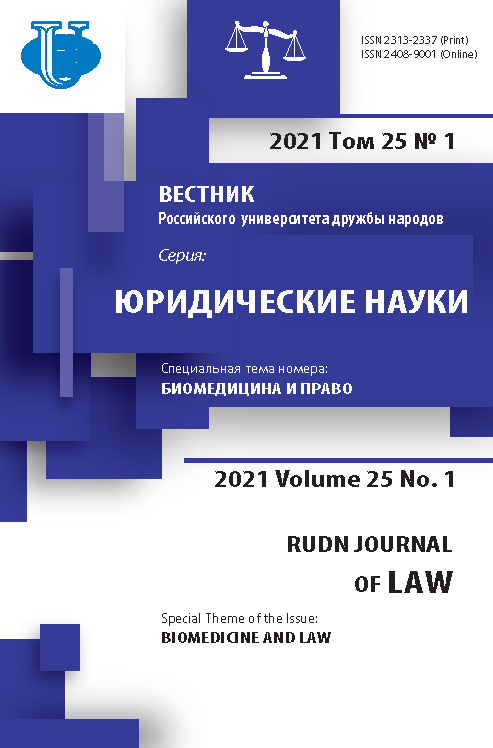Biomedicine issues in the European Court of Human Rights Case-Law: Boljević v. Serbia
- Authors: Bukuru J.1
-
Affiliations:
- Peoples' Friendship University of Russia (RUDN University)
- Issue: Vol 25, No 1 (2021): BIOMEDICINE AND LAW
- Pages: 144-163
- Section: GENETICS AND LAW
- URL: https://journals.rudn.ru/law/article/view/26040
- DOI: https://doi.org/10.22363/2313-2337-2021-25-1-144-163
- ID: 26040
Cite item
Full Text
Abstract
The article considers the recent case-law of the European Court of Human Rights in cases related to the use of the achievements of biomedicine in the light of the implementation of human rights and freedoms provided for by the European Convention on Human Rights and its additional protocols. In fact, the author pays special attention to the case of Boljević v. Serbia , in which the applicant, a Serbian citizen, alleged that his right to respect for private and family life had been violated as a result of the refusal of the Serbian national courts to reopen paternity proceedings, in which the applicant intended to prove, through DNA testing, that Mr. A was his biological father. It has to be mentioned that in this case in the 1970s the Serbian national courts issued final decision according to which Mr. A was not recognized as the applicant's biological father, and the applicant indicated that at that time it was impossible to carry out DNA test and he did not know about the existence of such decision (during the proceedings, the applicant was represented by a lawyer appointed by local authorities, since he was a minor), and that now there is such a possibility. In this connection, the applicant argued that the denial to satisfy his claims on procedural basis by the domestic courts violated his right to family and private life. The ECtHR ruled that Art. 8 of the Convention has been violated. In that case, the issues of compliance with a balance of private and public interests were dealt with (the interests of the applicant to establish his biological father identity and the interests of the state in maintaining legal certainty).
About the authors
Jean-Baptiste Bukuru
Peoples' Friendship University of Russia (RUDN University)
Author for correspondence.
Email: bukuru-zh@rudn.ru
Assistant, the Department of International Law, Law Institute
6 Miklukho-Maklaya str., Moscow, 117198, Russian FederationReferences
- Bévière-Boyer, B. & Bouffard, C. (2014) Réflexions sur le diagnostic préimplantatoire autour de l’arrêt de la Cour européenne des droits de l’homme du 28 août 2012. Médecine & Droit. (125), 34-39. (in French)
- Conor, O. & Ursula, K. (2014) O'Keeffe v Ireland and the duty of the state to identify and prevent child abuse. Journal of Social Welfare and Family Law. 36(3), 320-329. doi: 10.1080/09649069.2014.939884
- Duguet, A.M., Prudil, L. & Hrevtsova, R. (2014) Gestation pour autrui pratiquée à l’étranger: conséquences pour les couples français et évolution du cadre légal dans certains pays. Médecine & Droit. (125), 46-51. (in French)
- Joural, E. (2019) Selected Legislation and Jurisprudence. European journal of health law. (26), 255-269
- Kalinichenko, P.A. (2019) Development of Court Practice in Cases Involving Human Genomics: World Experience and Russia. Lex Russica. (6), 30-36. Doi.org/10.17803/1729-5920. 2019.151.6.030-036 (in Russian)
- Kalinichenko, P.A. & Kosilkin, S.V. (2019) Genomic Research: Council of Europe Standards and Legal Regulation in Russia. Courier of Kutafin Moscow State Law University (MSAL). (4), 108-118. Doi.org/10.17803/2311-5998.2019.56.4.108-118. (in Russian)
- Kaplina, O.V., Shylo, O.H. & Titko, I.A. (2019) Using the samples of human biological materials in the criminal procedure: the practice of the European Court of Human Rights. Wiadomosci Lekarskie (Warsaw, Poland: 1960). 72(8), 1576-1581
- Lazic, D. (2013) The European Court of Human Rights Grand Chamber: Scoppola v. Italy (No. 3). International Legal Materials. 52(1), 323-344. doi: 10.5305/intelegamate.52.1.0323
- Lyanov, M.M. (2018) Development of a DNA database in the Russian Federation: problems and development prospects. Siberian criminal procedural and criminalistic readings. 2 (20), 59-67. (in Russian)
- Margaria, A. (2020) Parenthood and Cross-Border Surrogacy: What Is ‘New’? The ECtHR’s First Advisory Opinion. Medical Law Review. 28(2), 412-425
- Raposo, V.L. (2016) The convention of human rights and biomedicine revisited: Critical assessment. The International Journal of Human Rights. 20(8), 1277-1294
- Saukkola, J. (2020) Child in the middle: Best interests of the child in the European Court of Human Rights in cases concerning public care and contact rights. University of Helsinki. Helsingin Yliopisto
- Seatzu, F. & Fanni, S. (2015) The Experience of the European Court of Human Rights with the European Convention on Human Rights and Biomedicine. Utrecht Journal of International and European Law. 31(81), 112-113. Doi: http://doi.org/10.5334/ujiel.dk
- Sidorenko, M.V. (2016) Legal certainty as a fundamental general legal idea: notion, essence and purpose. Bulletin of South Ural State University. Series “Law”. 16(3), 45-51. (in Russian)
- Steiner, E. (2003) Desperately Seeking Mother - Anonymous Births in the European Court of Human Rights. Child and Family Law Quarterly. 15(4), 425-448. Available from: SSRN: https://ssrn.com/abstract=2030906 [Accessed 18th November 2020]
- Trikoz, E.N. (2019) Protection of human rights in the context of the development of bioethics and genomics (thematic review of the international round table). RUDN Journal of Law. 23(1), 141-154. doi: 10.22363/2313-2337-2019-23-1-141-154
- Troitsky, S.V. (2017) The Principle of Legal Certainty as a Rule-making Defect Identified by the Constitutional Court of the Russian Federation. Bulletin of the International Institute of Economics and Law. 2 (27), 55-62. (in Russian)
- Wąsek-Wiaderek, M. (2019) Advisory Opinions of the European Court of Human Rights: Do National Judges Really Need This New Forum of Dialogue? In: Judicial Power in a Globalized World. Springer International Publishing. pp. 637-652
- Weiss, A. (2019) Mennesson v France and Advisory Opinion concerning the Recognition in Domestic Law of a Legal Parent-Child Relationship between a Child Born through a Gestational Surrogacy Arrangement Abroad and the Intended Mother. The Statelessness and Citizenship Review. 1(2), 343-349. Available from: https://statelessnessandcitizenship review.com/index.php/journal/article/view/115 [Accessed 18th November 2020]
Supplementary files















